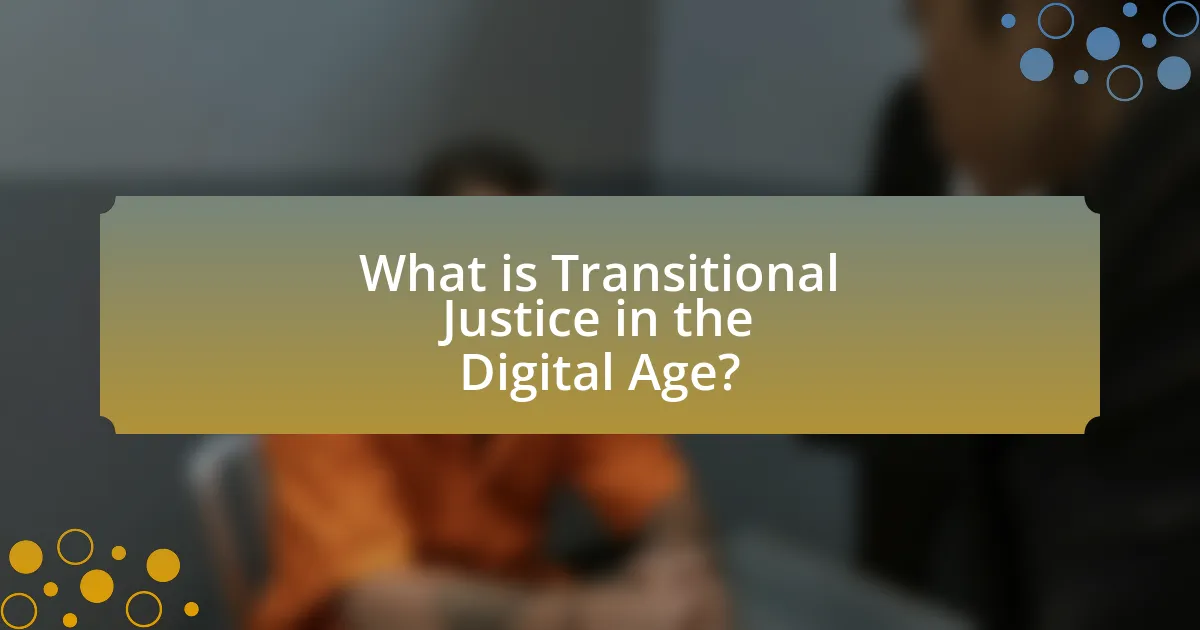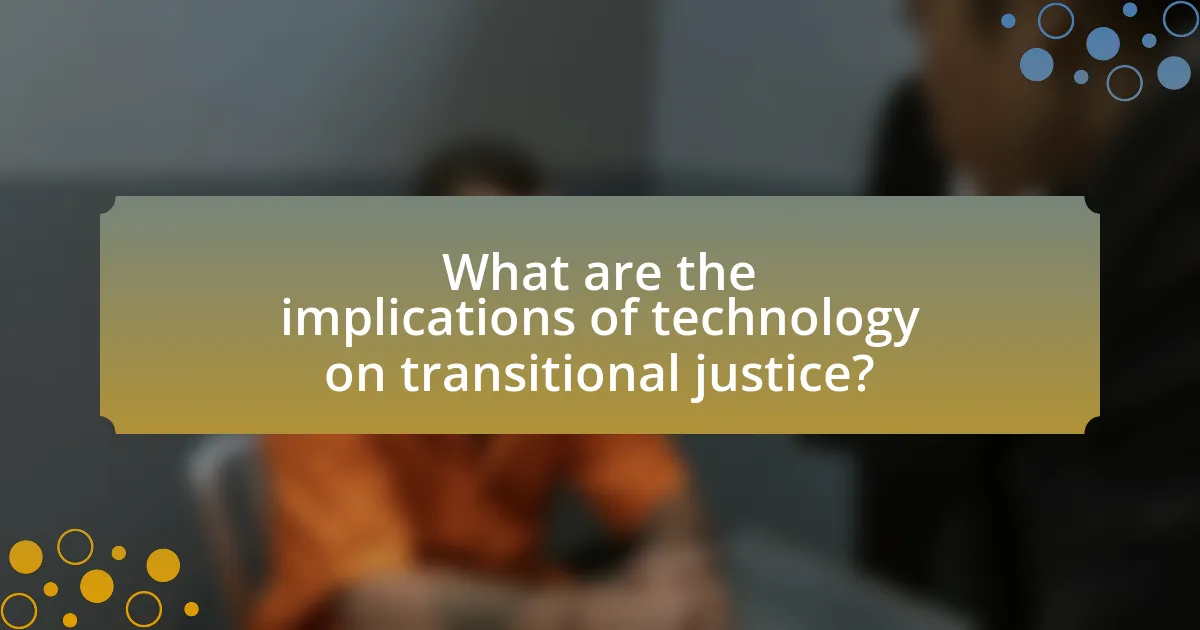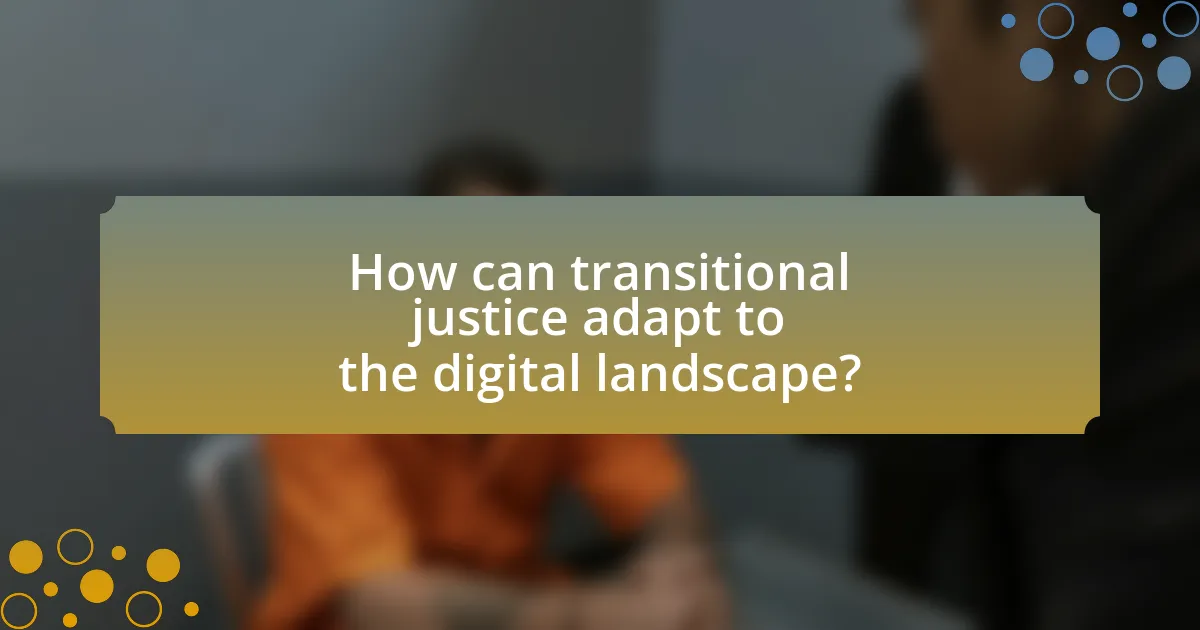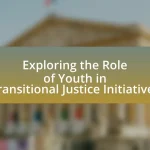Transitional Justice in the Digital Age encompasses the processes and mechanisms societies use to address past human rights violations while utilizing digital technologies for documentation, accountability, and public engagement. The article explores the evolution of transitional justice with digital advancements, highlighting key principles such as accountability, truth-seeking, reparations, and institutional reform. It examines how digital tools enhance the implementation of transitional justice, the significance of the digital age for public engagement, and the challenges posed by misinformation and privacy concerns. Additionally, it discusses best practices for effective digital transitional justice and anticipates future trends, including the impact of emerging technologies like AI and virtual reality on education and engagement in transitional justice processes.

What is Transitional Justice in the Digital Age?
Transitional Justice in the Digital Age refers to the processes and mechanisms that societies implement to address past human rights violations while leveraging digital technologies for documentation, accountability, and public engagement. This modern approach incorporates digital tools such as social media, online archives, and data analytics to enhance transparency, facilitate victim participation, and promote historical memory. For instance, initiatives like the International Criminal Court’s use of digital evidence have transformed how justice is pursued, allowing for more efficient gathering and dissemination of information related to atrocities.
How has the concept of transitional justice evolved with digital advancements?
The concept of transitional justice has evolved significantly with digital advancements by enhancing accessibility, transparency, and engagement in justice processes. Digital platforms facilitate the documentation and dissemination of human rights violations, allowing for broader participation from affected communities and international audiences. For instance, social media has been instrumental in mobilizing support for transitional justice initiatives, as seen during the Arab Spring, where digital tools helped raise awareness and document abuses in real-time. Additionally, digital archives and databases enable the preservation of testimonies and evidence, which are crucial for accountability and historical record-keeping. This evolution reflects a shift towards more inclusive and participatory approaches in transitional justice, leveraging technology to amplify voices that were previously marginalized.
What are the key principles of transitional justice in a digital context?
The key principles of transitional justice in a digital context include accountability, truth-seeking, reparations, and institutional reform. Accountability ensures that perpetrators of human rights violations are held responsible, which is increasingly facilitated by digital evidence such as social media posts and online documentation. Truth-seeking involves the collection and preservation of digital testimonies and records to establish an accurate historical narrative. Reparations can be enhanced through digital platforms that provide access to resources and support for victims. Institutional reform focuses on integrating digital tools to promote transparency and prevent future abuses, exemplified by the use of technology in monitoring and reporting mechanisms. These principles are essential for addressing past injustices and fostering reconciliation in societies transitioning from conflict or authoritarian rule.
How do digital tools enhance the implementation of transitional justice?
Digital tools enhance the implementation of transitional justice by improving access to information, facilitating communication, and enabling data collection and analysis. These tools, such as online platforms and social media, allow for broader public engagement and participation in transitional justice processes, ensuring that diverse voices are heard. For instance, digital archives can preserve testimonies and documents related to human rights violations, making them accessible for future generations and aiding in accountability efforts. Additionally, data analytics can identify patterns of violence and injustice, informing policy decisions and restorative measures. The use of digital tools thus strengthens the transparency and effectiveness of transitional justice initiatives.
Why is the digital age significant for transitional justice?
The digital age is significant for transitional justice because it enhances access to information, facilitates communication, and promotes accountability. Digital platforms enable victims to share their experiences widely, which can influence public opinion and policy decisions. For instance, social media has been instrumental in mobilizing support for justice initiatives, as seen in movements like #MeToo and #BlackLivesMatter, which have highlighted systemic injustices and led to legal reforms. Additionally, digital archives and databases allow for the preservation of evidence and testimonies, making it easier to document human rights violations and support legal proceedings. This increased visibility and accessibility contribute to a more informed and engaged society, ultimately strengthening the foundations of transitional justice.
What challenges does the digital age pose to traditional transitional justice mechanisms?
The digital age presents significant challenges to traditional transitional justice mechanisms, primarily through issues of information overload, digital misinformation, and the erosion of privacy. Information overload complicates the collection and analysis of evidence, as vast amounts of data can obscure relevant facts and hinder effective decision-making. Digital misinformation can undermine the credibility of transitional justice processes, as false narratives spread rapidly online, potentially influencing public perception and trust. Additionally, the erosion of privacy due to digital surveillance can deter victims from coming forward, as they may fear repercussions or exposure. These challenges necessitate the adaptation of transitional justice frameworks to effectively address the complexities introduced by digital technologies.
How can digital platforms facilitate public engagement in transitional justice processes?
Digital platforms can facilitate public engagement in transitional justice processes by providing accessible forums for dialogue, information sharing, and participation. These platforms enable victims, communities, and stakeholders to voice their experiences and opinions, fostering a sense of inclusion and ownership in the justice process. For instance, social media campaigns and dedicated websites can disseminate information about transitional justice initiatives, allowing broader public awareness and involvement. Research shows that online platforms have successfully mobilized communities in various contexts, such as the use of Twitter during the Arab Spring, where citizens shared information and organized protests, highlighting the potential of digital tools to enhance civic engagement in justice matters.

What are the implications of technology on transitional justice?
Technology significantly impacts transitional justice by enhancing documentation, promoting accountability, and facilitating public engagement. Digital tools enable the collection and preservation of evidence related to human rights violations, which is crucial for legal proceedings and historical records. For instance, organizations like the International Criminal Court utilize digital evidence to support prosecutions, demonstrating how technology can strengthen legal frameworks. Furthermore, social media platforms allow victims and activists to share their stories widely, raising awareness and fostering community support, which can lead to increased pressure on governments to address injustices. The use of technology also presents challenges, such as the risk of misinformation and privacy concerns, which can undermine the integrity of transitional justice processes.
How do social media and digital communication impact transitional justice?
Social media and digital communication significantly impact transitional justice by enhancing public engagement and facilitating the dissemination of information. These platforms allow victims and communities to share their narratives, which can influence public opinion and policy decisions regarding justice processes. For instance, the use of hashtags and viral campaigns has mobilized international attention to human rights abuses, as seen in movements like #MeToo and #BlackLivesMatter, which have prompted discussions on accountability and reform. Additionally, digital communication enables real-time documentation of events, providing evidence that can support claims for justice and reparations. This shift towards digital platforms also poses challenges, such as the potential for misinformation and the need for digital literacy among communities to navigate these spaces effectively.
What role does social media play in documenting human rights violations?
Social media serves as a crucial platform for documenting human rights violations by enabling real-time reporting and widespread dissemination of information. This immediacy allows individuals and organizations to share evidence, such as videos and images, that can highlight abuses occurring in various regions, often in situations where traditional media may be restricted or censored. For instance, during the Arab Spring, social media was instrumental in broadcasting instances of government repression, leading to increased international awareness and pressure for accountability. Furthermore, platforms like Twitter and Facebook facilitate the mobilization of global support, as seen in campaigns like #BlackLivesMatter, which not only document incidents of racial injustice but also foster community engagement and advocacy for change.
How can digital storytelling contribute to the narratives of transitional justice?
Digital storytelling can significantly enhance the narratives of transitional justice by providing a platform for marginalized voices and personal testimonies. This medium allows individuals affected by conflict or injustice to share their experiences in a compelling and accessible format, fostering empathy and understanding among broader audiences. For instance, projects like “Witness” by the International Coalition of Sites of Conscience utilize digital storytelling to document personal accounts of human rights violations, thereby contributing to collective memory and historical record. Furthermore, digital storytelling can facilitate community engagement and dialogue, as seen in initiatives that encourage collaborative storytelling among survivors, which helps to build trust and promote healing in post-conflict societies.
What are the risks associated with digital transitional justice?
Digital transitional justice carries several risks, including data privacy concerns, misinformation, and the potential for digital exclusion. Data privacy issues arise when sensitive information about victims or perpetrators is stored online, leading to potential breaches and misuse. Misinformation can proliferate through digital platforms, undermining the credibility of transitional justice processes and potentially harming victims’ narratives. Additionally, digital exclusion risks marginalizing individuals without access to technology or the internet, thereby limiting their participation in justice processes. These risks highlight the need for careful implementation and oversight in digital transitional justice initiatives.
How can misinformation affect the perception of transitional justice efforts?
Misinformation can significantly distort the perception of transitional justice efforts by creating confusion and mistrust among affected communities. When false narratives circulate, they can undermine the legitimacy of justice processes, leading to skepticism about their effectiveness and fairness. For instance, in post-conflict societies, misinformation about the intentions or outcomes of transitional justice mechanisms can fuel public disillusionment, as seen in the case of the International Criminal Court, where misleading information has led to perceptions of bias and ineffectiveness. This distortion can hinder reconciliation efforts, as communities may reject or oppose initiatives they believe are based on false premises.
What privacy concerns arise from using digital tools in transitional justice?
The primary privacy concern arising from the use of digital tools in transitional justice is the potential for unauthorized access to sensitive personal information. Digital platforms often collect and store data related to victims, witnesses, and perpetrators, which can be vulnerable to breaches or misuse. For instance, a report by the International Justice Resource Center highlights that digital archives can expose individuals to risks of retaliation or stigmatization, particularly in contexts where political or social tensions remain high. Additionally, the reliance on technology can lead to inadequate data protection measures, further compromising the privacy of those involved in transitional justice processes.

How can transitional justice adapt to the digital landscape?
Transitional justice can adapt to the digital landscape by leveraging technology to enhance accountability, promote transparency, and facilitate victim participation. Digital platforms can be utilized to document human rights violations, allowing for real-time data collection and analysis, which can inform justice processes. For instance, the use of social media and mobile applications has enabled victims to share their experiences and evidence of abuses, thereby increasing visibility and urgency in addressing these issues. Additionally, online archives and databases can preserve testimonies and historical records, ensuring that the narratives of marginalized communities are not lost. Research indicates that digital tools can improve outreach and engagement, making transitional justice mechanisms more accessible to diverse populations, particularly in remote or underserved areas.
What best practices should be adopted for effective digital transitional justice?
Effective digital transitional justice requires the adoption of best practices such as ensuring inclusivity, leveraging technology for documentation, and prioritizing data security. Inclusivity involves engaging diverse community voices to reflect the experiences of all affected groups, which enhances the legitimacy and effectiveness of justice processes. Utilizing technology for documentation, such as digital archives and online platforms, facilitates the collection and preservation of testimonies and evidence, making them accessible for future reference. Prioritizing data security is crucial to protect sensitive information and the identities of victims, as highlighted by the United Nations’ guidelines on digital security in transitional justice contexts. These practices collectively contribute to a more effective and trustworthy digital transitional justice framework.
How can stakeholders ensure inclusivity in digital transitional justice initiatives?
Stakeholders can ensure inclusivity in digital transitional justice initiatives by actively engaging diverse communities in the design and implementation processes. This engagement can be achieved through participatory methods, such as community consultations and workshops, which allow marginalized voices to contribute to the development of digital platforms. Research indicates that inclusive approaches lead to more effective justice outcomes, as seen in the case of the International Criminal Court’s outreach programs, which successfully integrated local perspectives to enhance community trust and participation. By prioritizing the involvement of underrepresented groups, stakeholders can create digital initiatives that reflect the needs and experiences of all affected populations.
What strategies can be employed to safeguard data integrity in transitional justice?
To safeguard data integrity in transitional justice, implementing robust data management systems is essential. These systems should include encryption protocols to protect sensitive information, ensuring that data remains confidential and unaltered during storage and transmission. Additionally, employing regular audits and access controls can help monitor data usage and prevent unauthorized alterations. For instance, the International Criminal Court utilizes strict data governance policies to maintain the integrity of evidence collected during investigations, demonstrating the effectiveness of these strategies in real-world applications.
What future trends can we expect in transitional justice within the digital realm?
Future trends in transitional justice within the digital realm will likely include increased reliance on digital platforms for documentation, communication, and community engagement. As technology evolves, transitional justice mechanisms will harness social media and online tools to amplify voices of victims and facilitate broader participation in justice processes. For instance, the use of blockchain technology may enhance transparency and accountability in documenting human rights violations, as seen in initiatives like the Digital Witness project. Additionally, artificial intelligence could assist in analyzing large datasets to identify patterns of abuse, thereby informing policy decisions. These trends reflect a shift towards more inclusive and accessible approaches to transitional justice, leveraging digital innovations to address historical injustices effectively.
How might emerging technologies like AI influence transitional justice processes?
Emerging technologies like AI can significantly influence transitional justice processes by enhancing data analysis, improving evidence collection, and facilitating communication among stakeholders. AI algorithms can analyze vast amounts of data from various sources, such as social media and public records, to identify patterns of human rights violations, thereby aiding investigations. For instance, AI-driven tools have been used to analyze satellite imagery to document war crimes, providing concrete evidence for legal proceedings. Additionally, AI can streamline the process of gathering testimonies by employing natural language processing to transcribe and categorize survivor accounts, making it easier for truth commissions to access and analyze this information. These advancements not only improve the efficiency of transitional justice mechanisms but also increase the potential for accountability and reconciliation in post-conflict societies.
What role will virtual reality play in educating about transitional justice?
Virtual reality (VR) will play a significant role in educating about transitional justice by providing immersive experiences that enhance understanding of complex historical and social issues. VR can simulate environments and scenarios related to past injustices, allowing users to engage with narratives that highlight the experiences of victims and the impact of conflict. For instance, studies have shown that immersive storytelling in VR can increase empathy and awareness, making abstract concepts of justice more tangible. Research conducted by the University of Southern California found that participants who experienced VR narratives related to social issues reported higher levels of emotional engagement and understanding compared to traditional media formats. This indicates that VR can be an effective educational tool in fostering a deeper comprehension of transitional justice processes and their significance in post-conflict societies.
What practical steps can organizations take to implement digital transitional justice?
Organizations can implement digital transitional justice by establishing online platforms for truth-telling, documentation, and community engagement. These platforms facilitate the collection of testimonies and evidence from victims of human rights abuses, ensuring that their voices are heard and recorded. For instance, organizations can utilize digital archives to preserve historical records and testimonies, which can be accessed by the public and researchers, promoting transparency and accountability.
Additionally, organizations should leverage social media and digital communication tools to raise awareness and foster dialogue about transitional justice issues, engaging a broader audience. Implementing data protection measures is crucial to safeguard the privacy and security of individuals sharing sensitive information.
Furthermore, partnerships with technology companies can enhance the development of innovative tools for data collection and analysis, ensuring that the digital justice processes are efficient and effective. These steps collectively contribute to a more inclusive and accessible approach to transitional justice in the digital age.


